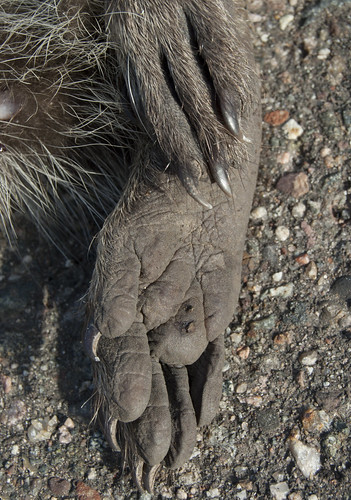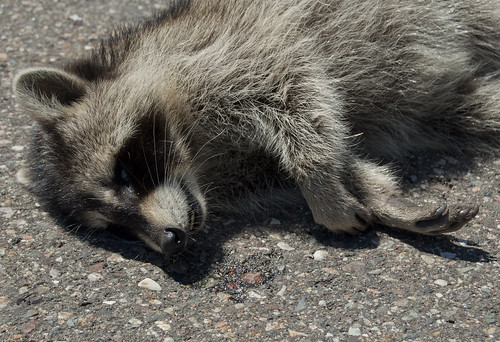Raccoons have larger litters in areas where mortality rates are high. Unsurprisingly, the leading cause of death for raccoons is traffic. These animals are not fast by any means, and when shuffling across the freeway, they cannot dodge oncoming traffic (that's not to say cars cannot brake for raccoons -- I see almost no excuse for hitting a raccoon on a 25-mph residential street, for instance). In addition, raccoons are omnivorous and will scavenge the dead bodies of other animals along the roadside, making them even more prone to being hit by cars.
Today, I spotted a young raccoon along M-28. It had only recently died. I initially photographed it around 1 PM, when the sun was high in the sky and glaring down -- creating some pretty harsh shadows, something that just isn't conducive to the type of photography I want to achieve.
I took a few photographs, including the one above, then returned at around 6:30 PM, as the sun was lower in the sky and traffic was much more sparse.
I will forever be uncomfortable photographing roadkill along the highway, as I can only imagine what people in their cars must be thinking. I often wait until there are no cars coming in either direction before I crouch down and point my lens at the subject. Luckily, the traffic on U.P. highways is often non-existent, especially in the morning or evening.

By 6:30 PM, the raccoon, having sat in the sun all day, was starting to smell like death. Flies were swarming around its nose and mouth, though they vacated the premises while I photographed. It's interesting to note how brown this individual's teeth are.


Raccoon feet fascinate me, so I made sure to photograph this individual's hind paws. The claws were surprisingly sharp, and the vibrissae are very visible. According to Wikipedia, these specialized hairs are used to aid in identifying objects before they are even touched.
I have photographed three roadkilled raccoons for this project, and each one of them has been a different experience. They are beautiful animals in both life and death; often the closest we get to see them is when they are dead, on the roadside.
I have photographed three roadkilled raccoons for this project, and each one of them has been a different experience. They are beautiful animals in both life and death; often the closest we get to see them is when they are dead, on the roadside.





It's nice that you have the opportunity to photograph on the highways without being completely bombarded with vehicles. In most places I've driven through in California it's just too busy all the time. I also really love seeing the differently lit shots together. It's amazing how the subject feels so different because of the light.
ReplyDeleteYeah, I think I'm too scared to photograph anything along the highways downstate. Up here the speed limit is only 55 mph, and the highways are undivided, with a very wide shoulder, but downstate, the freeways are terrifying (probably not as terrifying as California's freeways, so I've heard). It's a shame too, because I've seen so many critters that I've wanted to photograph and get a closer look at, but I just can't due to how dangerous the highways are.
ReplyDeleteI remember one time my mom was driving, and a raccoon family had started crossing the road, so she pulled off to the side to get a few pictures, and when she was done, she got back into the car just in time to see a car hit the mother and all but one baby and kill them. She ran out into the middle of the road, picked up the baby, gave him to me to hold, and we hurried him to the nearest wild life center. I remember the poor baby squeaking for his mother, the sad look in his eyes...I remember nicknaming him "Googly" because his eyes were pretty big lol
ReplyDelete